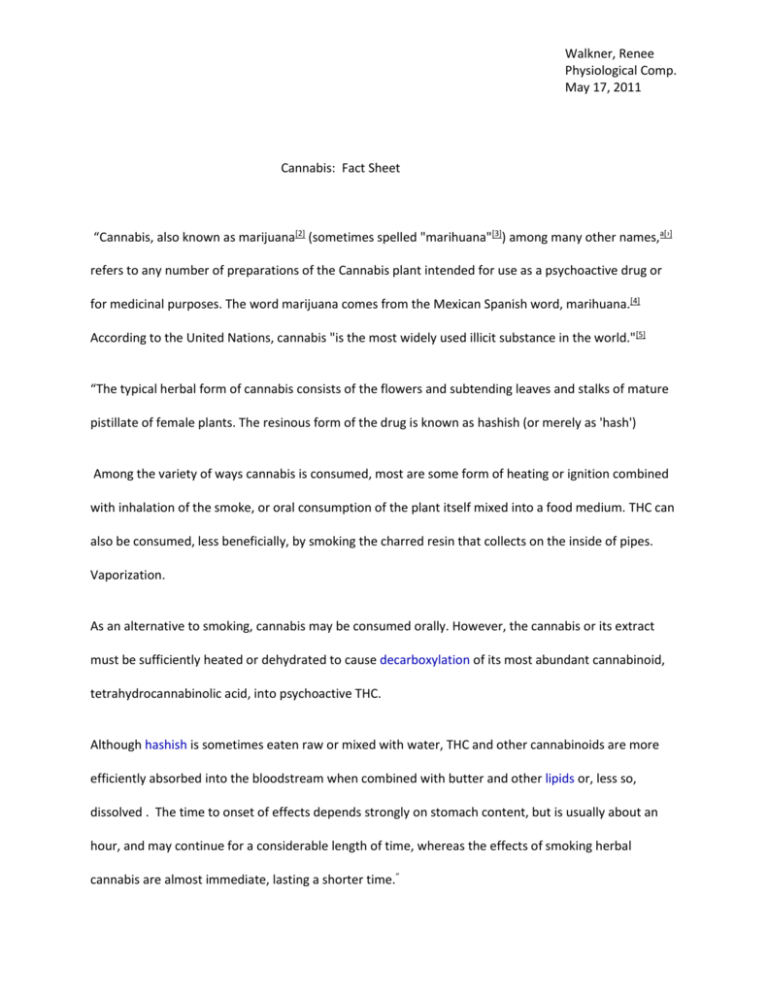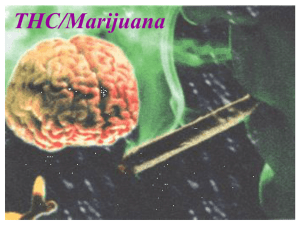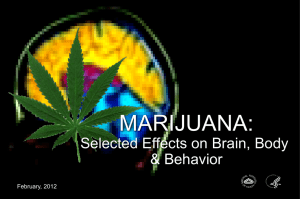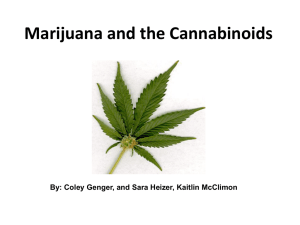Cannabis
advertisement

Walkner, Renee Physiological Comp. May 17, 2011 Cannabis: Fact Sheet “Cannabis, also known as marijuana[2] (sometimes spelled "marihuana"[3]) among many other names,a[›] refers to any number of preparations of the Cannabis plant intended for use as a psychoactive drug or for medicinal purposes. The word marijuana comes from the Mexican Spanish word, marihuana.[4] According to the United Nations, cannabis "is the most widely used illicit substance in the world."[5] “The typical herbal form of cannabis consists of the flowers and subtending leaves and stalks of mature pistillate of female plants. The resinous form of the drug is known as hashish (or merely as 'hash') Among the variety of ways cannabis is consumed, most are some form of heating or ignition combined with inhalation of the smoke, or oral consumption of the plant itself mixed into a food medium. THC can also be consumed, less beneficially, by smoking the charred resin that collects on the inside of pipes. Vaporization. As an alternative to smoking, cannabis may be consumed orally. However, the cannabis or its extract must be sufficiently heated or dehydrated to cause decarboxylation of its most abundant cannabinoid, tetrahydrocannabinolic acid, into psychoactive THC. Although hashish is sometimes eaten raw or mixed with water, THC and other cannabinoids are more efficiently absorbed into the bloodstream when combined with butter and other lipids or, less so, dissolved . The time to onset of effects depends strongly on stomach content, but is usually about an hour, and may continue for a considerable length of time, whereas the effects of smoking herbal cannabis are almost immediate, lasting a shorter time.” Walkner, Renee Physiological Comp. May 17, 2011 Although the extent of the medicinal value of cannabis has been disputed, and despite the opposition to research and use put forward by most national governments, it does have several well-documented beneficial effects. Among these are: the amelioration of nausea and vomiting, stimulation of hunger in chemotherapy and AIDS patients, lowered intraocular eye pressure (shown to be effective for treating glaucoma), as well as gastrointestinal illness. Its effectiveness as an analgesic has been suggested—and disputed—as well. There are several methods for administration of dosage, including vaporizing or smoking dried buds, drinking, or eating extracts, and taking capsules. The comparable efficacy of these methods was the subject of an investigative study[5] conducted by the National Institutes of Health. Synthetic cannabinoids are available as prescription drugs in some countries. Examples include Marinol, available in the United States and Canada, and Cesamet, available in Canada, Mexico, the United Kingdom, and also in the United States. Some street names of cannabis are: Pot Weed Grass Ganja Skun Hashish/Charas Bhang Hash oil Reefe Herb Boom Blubbers Gangster Cannabis effects on the brain: Walkner, Renee Physiological Comp. May 17, 2011 How Does Marijuana Affect the Brain? “Scientists have learned a great deal about how THC acts in the brain to produce its many effects. When someone smokes marijuana, THC rapidly passes from the lungs into the bloodstream, which carries the chemical to the brain and other organs throughout the body. THC acts upon specific sites in the brain, called cannabinoid receptors, kicking off a series of cellular reactions that ultimately lead to the "high" that users experience when they smoke marijuana. Some brain areas have many cannabinoid receptors; others have few or none. The highest density of cannabinoid receptors are found in parts of the brain that influence pleasure, memory, thinking, concentrating, sensory and time perception, and coordinated movement.1 Not surprisingly, marijuana intoxication can cause distorted perceptions, impaired coordination, difficulty with thinking and problem solving, and problems with learning and memory. Research has shown that, in chronic users, marijuana's adverse impact on learning and memory can last for days or weeks after the acute effects of the drug wear off.2 As a result, someone who smokes marijuana every day may be functioning at a suboptimal intellectual level all of the time. Research into the effects of long-term cannabis use on the structure of the brain has yielded inconsistent results. It may be that the effects are too subtle for reliable detection by current techniques. A similar challenge arises in studies of the effects of chronic marijuana use on brain function. Brain imaging studies in chronic users tend to show some consistent alterations, but their connection to impaired cognitive functioning is far from clear. This uncertainty may stem from confounding factors such as other drug use, residual drug effects, or withdrawal symptoms in long-term chronic users.” Walkner, Renee Physiological Comp. May 17, 2011 Health risks from cannabis abuse/signs and symptoms of abuse:”Marijuana is the most commonly abused illicit drug in the United States. It is a dry, shredded green and brown mix of flowers, stems, seeds, and leaves derived from the hemp plant Cannabis sativa. The main active chemical in marijuana is delta-9-tetrahydrocannabinol, or THC for short”. How is Marijuana Abused? “Marijuana is usually smoked as a cigarette (joint) or in a pipe. It is also smoked in blunts, which are cigars that have been emptied of tobacco and refilled with a mixture of marijuana and tobacco. This mode of delivery combines marijuana's active ingredients with nicotine and other harmful chemicals. Marijuana can also be mixed in food or brewed as a tea. As a more concentrated, resinous form, it is called hashish; and as a sticky black liquid, hash oil.* Marijuana smoke has a pungent and distinctive, usually sweet-and-sour odor.” Addictive Potential “Long-term marijuana abuse can lead to addiction; that is, compulsive drug seeking and abuse despite the known harmful effects upon functioning in the context of family, school, work, and recreational activities. Estimates from research suggest that about 9 percent of users become addicted to marijuana; this number increases among those who start young (to about 17 percent) and among daily users (25-50 percent). Long-term marijuana abusers trying to quit report withdrawal symptoms including: irritability, sleeplessness, decreased appetite, anxiety, and drug craving, all of which can make it difficult to remain abstinent. These symptoms begin within about 1 day following abstinence, peak at 2-3 days, and subside within 1 or 2 weeks following drug cessation.” Walkner, Renee Physiological Comp. May 17, 2011 Marijuana and Mental Health “A number of studies have shown an association between chronic marijuana use and increased rates of anxiety, depression, and schizophrenia. Some of these studies have shown age at first use to be an important risk factor, where early use is a marker of increased vulnerability to later problems. However, at this time, it is not clear whether marijuana use causes mental problems, exacerbates them, or reflects an attempt to self-medicate symptoms already in existence. Chronic marijuana use, especially in a very young person, may also be a marker of risk for mental illnesses - including addiction - stemming from genetic or environmental vulnerabilities, such as early exposure to stress or violence. Currently, the strongest evidence links marijuana use and schizophrenia and/or related disorders.4 High doses of marijuana can produce an acute psychotic reaction; in addition, use of the drug may trigger the onset or relapse of schizophrenia in vulnerable individuals”. Walkner, Renee Physiological Comp. May 17, 2011 References 1. http://en.wikipedia.org/wiki/Cannabis_(drug) 2. http://en.wikipedia.org/wiki/Cannabis_consumption 3.htthttp://www.medindia.net/patients/patientinfo/cannabis_streetnames.htmp://en.wikipedia.org/wi ki/Medical_cannabis 4. http://www.medindia.net/patients/patientinfo/cannabis_streetnames.htm 5. http://en.wikipedia.org/wiki/Physiological_effects_of_cannabis 6. http://www.drugabuse.gov/Infofacts/marijuana.html









